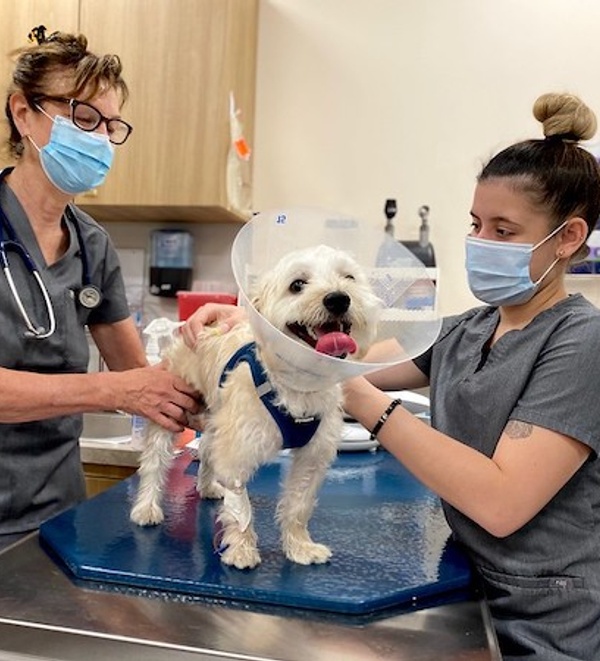
Femoral Head Ostectomy: FHO Surgery for Dogs & Cats
Femoral head ostectomy, or FHO, is a surgical procedure in which the top portion of the femur (thigh bone) is removed, usually due to an injury or genetic defect of the bone that can’t be surgically repaired and is causing pain.
The femoral head and neck — the tip of the femur, or the “ball” part of the ball and socket joint — is the only part of the bone that is removed.
Usually, the first sign of a problem is limping, or holding up one of the hindlimbs and not wanting to place weight on it. This may happen suddenly, after an injury, or it could be something that develops slowly over time.
Some pets may cry or yelp, and won’t want you to touch the leg. Others, however, may have subtler signs, and still go on about their daily activities. When in doubt, schedule a vet visit if your dog or cat is limping.
What are the causes of a diseased or damaged hip?
A fracture or dislocation of the femoral head may occur with an injury, such as a fall or being hit by a car.
Another cause is arthritis, which is a condition that typically develops with age, though it may occur in younger pets secondary to conditions such as canine hip dysplasia (a malformation where the hip joint is “shallow” and therefore less stable).
Another possibility is a deterioration of that part of the bone caused by a genetic condition. The most common example is Legg-Perthes disease. Most commonly seen miniature and toy breed dogs, Legg-Perthes disease is the result of a vascular abnormality that causes the head of the femur to lose circulation and die, then wither away or collapse.
An FHO procedure can relieve all of these conditions.
LEARN MORE ABOUT SURGERY AT BOND VET
How is the need for an FHO determined?
This procedure is relatively common in dogs and cats.
Symptoms of hip pain at home or during a physical exam in a vet clinic will give your veterinarian clues to explore further.
The next step is an x-ray to confirm the diagnosis.
If x-rays reveal one of the below, your vet may recommend an FHO.
- Certain hip or femoral head/joint fractures that can’t be surgically repaired (or, if full surgical repair isn’t an option financially, an FHO may be a more affordable option that still offers a very good quality of life).
- A severely arthritic hip joint, where the cartilage is completely worn down.
- Certain types of hip dislocations.
- A degenerative disease of the femoral head, such as Legg-Perthes disease.
What does the surgery entail?
Surgery involves removal of the femoral head and neck — the upper tip of the femur (thigh bone) that normally fits into the hip joint. Initially, the leg muscle hold the femur in place. Eventually, scar tissue referred to as a "false joint" develops and restores pain-free mobility.
The hip surgery can result in a slightly abnormal gait since the affected leg will be just a bit shorter than the other, and it may result in slightly decreased range of motion. However, most dogs feel much better after they’ve healed from the surgery, because the source of their pain has been removed.
For the surgery, your pet will be fasted overnight (or, they may just stay overnight in the hospital the night before). Then, they’ll have the surgery and remain under observation afterward.
Your veterinary surgeon may recommend keeping your pet in the hospital for 1-2 days, for intravenous pain meds, monitoring, and restricted activity so they can heal. But, this recommendation will vary by individual pet.
What does recovery look like?
As far as recoveries go, an FHO tends to be simpler and faster than many other types of orthopedic surgeries. This is because your pet will have a shorter restriction on exercise. After approximately a week of rest, physical activity is recommended to promote callus growth in the hip joint, which makes the area more stable and comfortable to walk on. Your vet will guide you regarding post-surgery exercise to build muscle mass and restore near normal function to the affected leg — make sure to follow their recommendations and give them a call if you have any questions.
After their surgery, your pet will receive:
- Pet-safe anti-inflammatory medication.
- An Elizabethan collar to prevent licking and chewing of the incision site.
- A bandage over the area.
Can you prevent the need for an FHO?
For most pets, the best way to prevent a fractured femoral head and the need for an FHO surgery is to prevent injuries.
Keep your pet indoors or when outdoors keep them on a leash on a leash to avoid vehicle-related injuries. And, if you have a small breed dog, consider purchasing a set of stairs or a ramp designed for pets so they can get on and off the bed or couch comfortably.
For all pets, avoiding obesity is also a good way to reduce the risk of injuries since it decreases the pressure on bones and joints.
For pets with a genetic predisposition toward Legg-Perthes disease — such as small and toy breed dogs, and pets with a relative who has the condition — talk to your vet about the best recommendations for your unique pet.